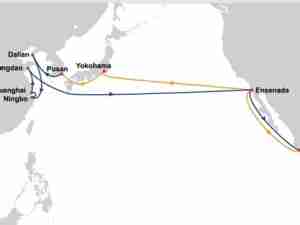Maersk’s shipping profit doubles on Europe-Asia demand
By: Reuters | May 21 2014 at 12:35 PM | Liner Shipping
Profit at A.P. Moller-Maersk’s container shipping business, a bellwether for global trade, more than doubled in the first quarter as demand on the world’s busiest route between Asia and Europe picked up and it cut costs.
That helped the Danish shipping and oil group beat forecasts for net profit and prompted the company to raise its outlook for the full year.
The jump in profit at Maersk Line, the world’s largest container shipping company, is an early sign the company is starting to recover from several tough years in the industry.
Container shipping firms have been struggling with overcapacity and too few goods to transport as a result of a weak global economy.
A.P. Moller-Maersk Chief Executive Nils Smedegaard Andersen said he was surprised by the strength of demand.
“It is a little bit surprising that volume to and from Europe is growing very nicely, particularly export out of Europe is developing very well,” he said.
Maersk Line raised its 2014 profit outlook to beat last year’s $1.5 billion rather than matching it, partly driven by increasing demand in China for European food, fashion and car parts.
Historically, goods on this shipping route have mainly been transported from Asia to Europe. But this could be about to change as a growing middle class in China buys more goods from Europe, said Lars Jensen from maritime analysis company SeaIntel.
Maersk, which has about 15 percent of the global market, expects demand for containers to increase by 4-5 percent this year.
“The report is a positive signal when it comes from a conservative company after the first quarter,” analyst Jesper Christensen from Alm. Brand Markets said.
Sydbank analyst Jacob Pedersen said Maersk Line was far ahead of most competitors. German shipping company Hapag-Lloyd earlier in May reported a loss for the first quarter and Singapore based Neptune Orient Lines also reported a loss.
“Maersk Line has been much better than other shipping companies to reduce costs,” Jensen said.
Alliance Delayed
Maersk Line also said the start date for its alliance with two other global shippers, Switzerland-based MSC Mediterranean Shipping Company and France’s CMA CGM, would be pushed back from the middle of this year while they wait for regulatory clearance.
The alliance, set up to tackle overcapacity, was given the go-ahead by U.S. regulators in March but is still waiting for other countries including China.
Group net profit rose to $1.207 billion in the first quarter, beating an average forecast of $1.072 billion in a Reuters poll of analysts.
Maersk Line, which contributes around half of the group’s total revenue, reported a 123 percent rise in net profit.
The result was supported by a 10 percent drop in fuel costs to $1.2 billion due to 2.9 percent lower fuel consumption and a 7.2 percent decrease in the average fuel price.
A.P. Moller-Maersk reiterated its overall group outlook for the full year to be significantly above the 2013 net profit of $3.8 billion. But the company raised its forecast for profit excluding disposals to around $4.0 billion from an earlier $3.6 billion.
Maersk Line’s costs per unit fell by 9 percent and volumes increased to 2.2 million forty-foot containers (FFE) from 2.1 million a year earlier. (Reuters)





